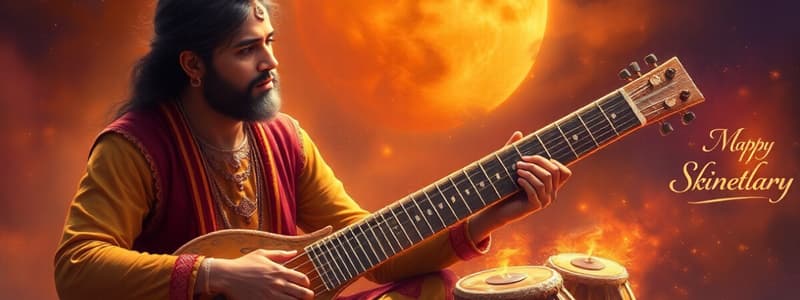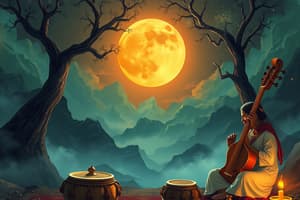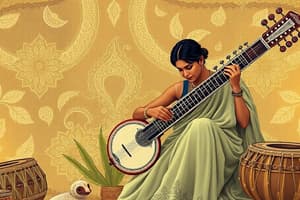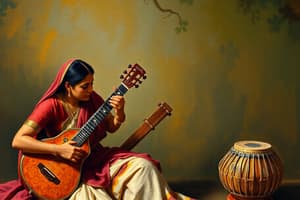Podcast
Questions and Answers
In Indian classical music, the three integral components inherent to nearly all pieces include the raga, a single melodic line, a constant fixed note also described as a ______, and the tala which encapsulates the overarching rhythm.
In Indian classical music, the three integral components inherent to nearly all pieces include the raga, a single melodic line, a constant fixed note also described as a ______, and the tala which encapsulates the overarching rhythm.
drone
The tabla, a percussion instrument fundamental in Indian classical music, consists of two drums, the dayan typically crafted from ______, and the bayan typically crafted from metal.
The tabla, a percussion instrument fundamental in Indian classical music, consists of two drums, the dayan typically crafted from ______, and the bayan typically crafted from metal.
wood
The ______, utilized in Indian classical music, possesses only the capability to produce the drone aspect, achieved through four elongated strings which are plucked sequentially, therefore lending an atmosphere and governing the mode or scale, integral to the raga.
The ______, utilized in Indian classical music, possesses only the capability to produce the drone aspect, achieved through four elongated strings which are plucked sequentially, therefore lending an atmosphere and governing the mode or scale, integral to the raga.
tambura
In the construction of the tabla, the drumheads are covered with either goat or ______ hide and different parts make different sounds.
In the construction of the tabla, the drumheads are covered with either goat or ______ hide and different parts make different sounds.
The ______, a drone-generating instrument within Indian classical music, is characterized as a compact reed-free organ devoid of keys, employing bellows manually operated to produce the drone tone.
The ______, a drone-generating instrument within Indian classical music, is characterized as a compact reed-free organ devoid of keys, employing bellows manually operated to produce the drone tone.
Within the framework of Indian classical music, a ______ is affixed to the center of both drumheads, composed of a fusion of flour and iron filings, which, upon repercussion, begets a bell-like resonance.
Within the framework of Indian classical music, a ______ is affixed to the center of both drumheads, composed of a fusion of flour and iron filings, which, upon repercussion, begets a bell-like resonance.
The ______, pivotal in Hindustani music, empowers the solo singer to create variations for the melody line, also known as the raga, and vary in mood, incorporating traditional accompanying instruments such as the tabla and sitar.
The ______, pivotal in Hindustani music, empowers the solo singer to create variations for the melody line, also known as the raga, and vary in mood, incorporating traditional accompanying instruments such as the tabla and sitar.
The ______ is a long-necked string instrument, integral to Indian classical music, characterized by three distinct sets of strings.
The ______ is a long-necked string instrument, integral to Indian classical music, characterized by three distinct sets of strings.
Within the tripartite string configuration of the sitar, one set comprising four strings furnishes the ______, another involving two or three strings tenders a rhythmic ostinato (drone), and the terminal assortment embodying nine or thirteen sympathetic strings vibrates beneath, bestowing upon the sitar its distinctively jangling timbre.
Within the tripartite string configuration of the sitar, one set comprising four strings furnishes the ______, another involving two or three strings tenders a rhythmic ostinato (drone), and the terminal assortment embodying nine or thirteen sympathetic strings vibrates beneath, bestowing upon the sitar its distinctively jangling timbre.
Although the music varies between different parts of India, the pieces share the common idea of having three main parts: the ______, a single melody line, accompanied by a constant fixed note (a drone), and the tala, which is the rhythm.
Although the music varies between different parts of India, the pieces share the common idea of having three main parts: the ______, a single melody line, accompanied by a constant fixed note (a drone), and the tala, which is the rhythm.
Flashcards
Hindustani Music
Hindustani Music
The north Indian system of classical music, known for its freer form and improvisation focusing on a solo singer.
Carnatic Music
Carnatic Music
The south Indian system of classical music, known for its rigid musical structure which emphasizes vocal music.
Sitar
Sitar
A long-necked string instrument with three sets of strings used in Indian classical music.
Tabla
Tabla
Signup and view all the flashcards
Tambura
Tambura
Signup and view all the flashcards
Raga
Raga
Signup and view all the flashcards
Drone
Drone
Signup and view all the flashcards
Tala
Tala
Signup and view all the flashcards
Surpeti
Surpeti
Signup and view all the flashcards
Alla Rakha, Zakir Hussain
Alla Rakha, Zakir Hussain
Signup and view all the flashcards
Study Notes
Indian Classical Music Structure
- Indian classical music includes the raga, drone, and tala.
- Raga is the melody line.
- Drone is a constant fixed note.
- Tala is the rhythm.
- The sitar, tabla, and tambura are instruments that play each of these parts.
- The music has been passed down for over 3,000 years.
Sitar Details
- A long-necked string instrument.
- Includes three sets of strings.
- Four strings provide the melody (raga).
- Two or three strings supply a rhythmic drone.
- Nine to thirteen "sympathetic" strings vibrate.
- It is balanced between the left foot and the right knee when played.
- Produces a characteristic jangling sound.
Tabla Details
- It is a pair of drums.
- The right drum is called dayan and is made of wood.
- The left drum is called bayan and is made of metal.
- Drumheads are covered with goat or cow hide.
- Different drum parts create different sounds.
- It plays the tala, a cycle of beats used throughout the piece.
- At the center of both drums is a black spot of flour and iron, which, when struck, makes a bell-like sound.
Tambura Details
- Also known as tanpura.
- Only plays the drone part.
- Features four long strings plucked one after another.
- The drone sets the musical mode or scale of the raga.
- The drone provides the music an atmosphere.
Surpeti Details
- An alternative Indian drone instrument.
- It is a small reed-free organ.
- No keys.
- Has hand-pumped bellows to produce the drone sound.
- Includes an electronic version used today.
Notable Players
- Ravi Shankar was an internationally famous sitar player.
- George Harrison of the Beatles was his student in 1966.
- Annapurna Devi was Shankar's former wife and an exceptional sitar player.
- Anoushka Shankar is Shankar's daughter, also an exceptional sitar player.
- Alla Rakha and Zakir Hussain are legendary tabla players.
Further Information
- Hindustani music (North Indian) focuses on a solo singer's improvisation.
- Carnatic music (South Indian) relies on a rigid musical structure.
- Instruments like tabla and sitar are increasing in popularity outside of South Asia.
Studying That Suits You
Use AI to generate personalized quizzes and flashcards to suit your learning preferences.




